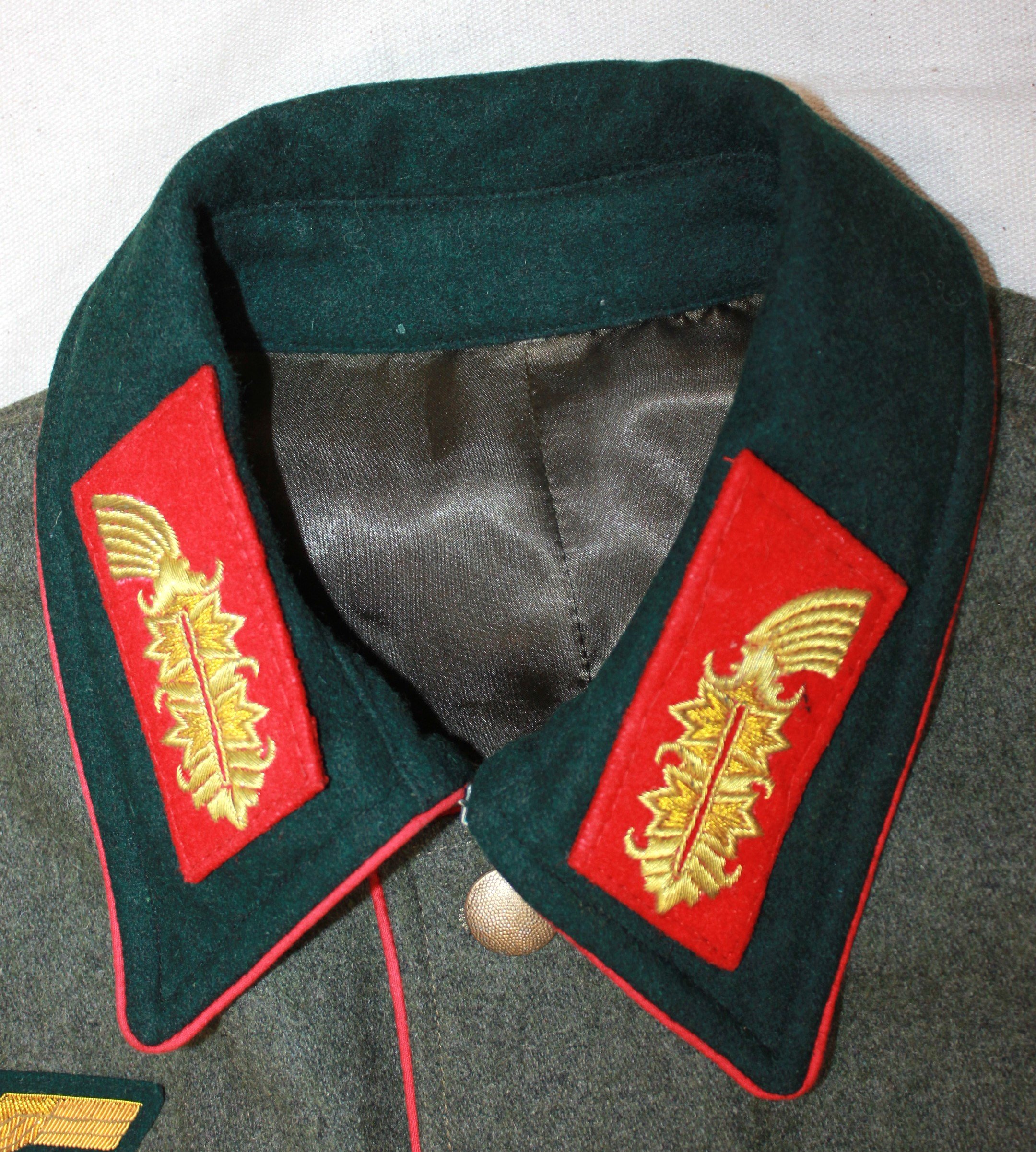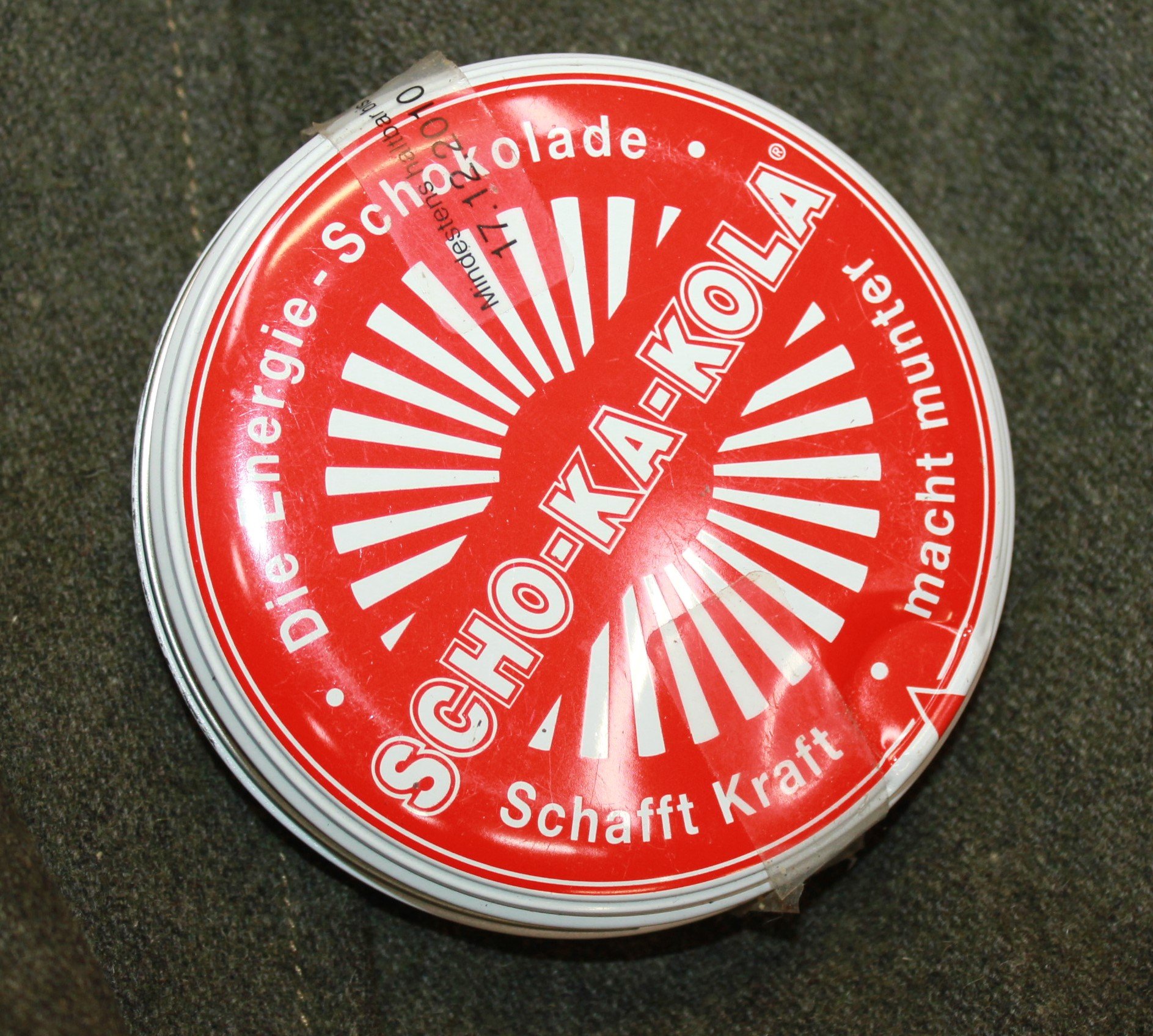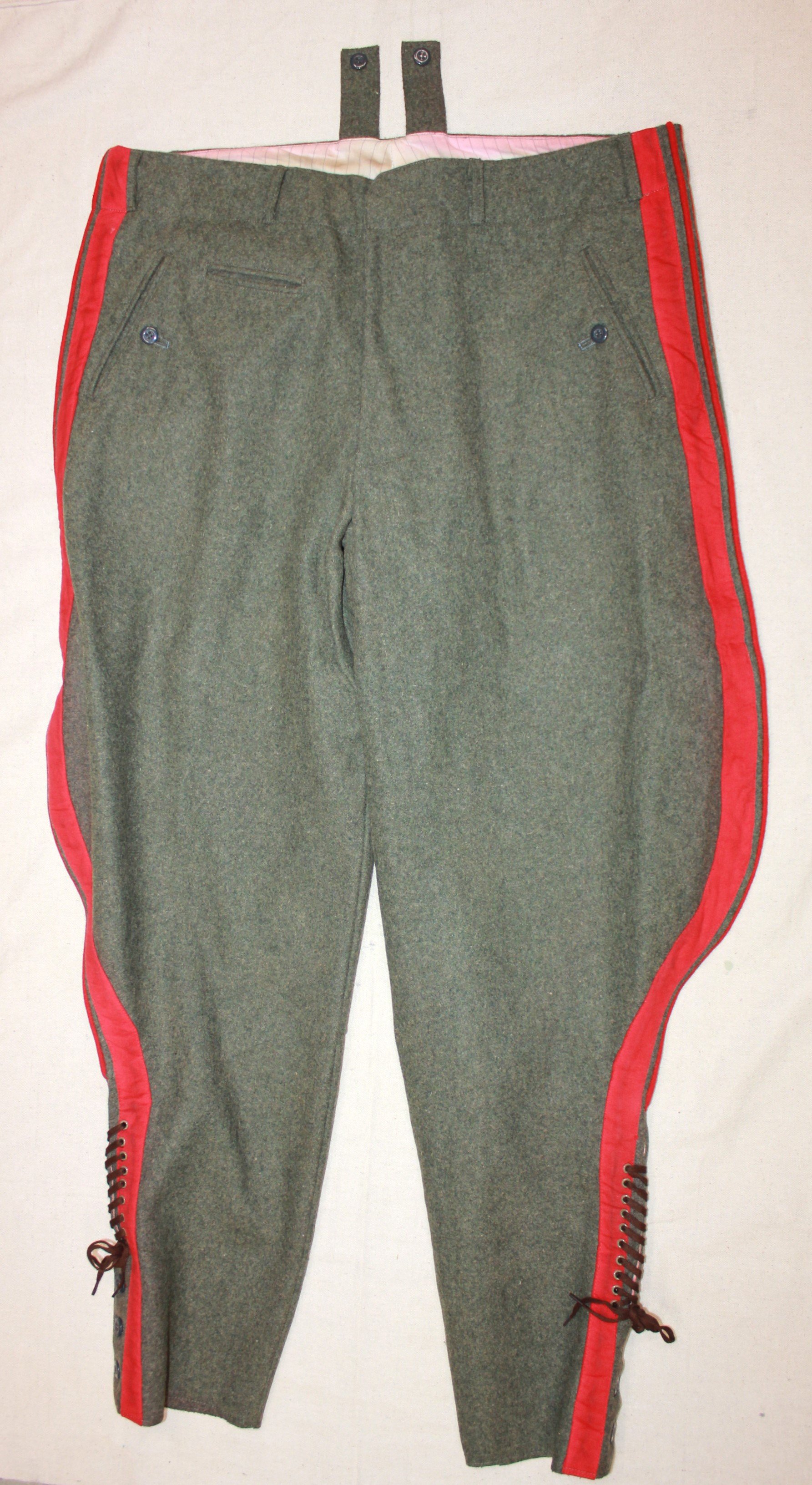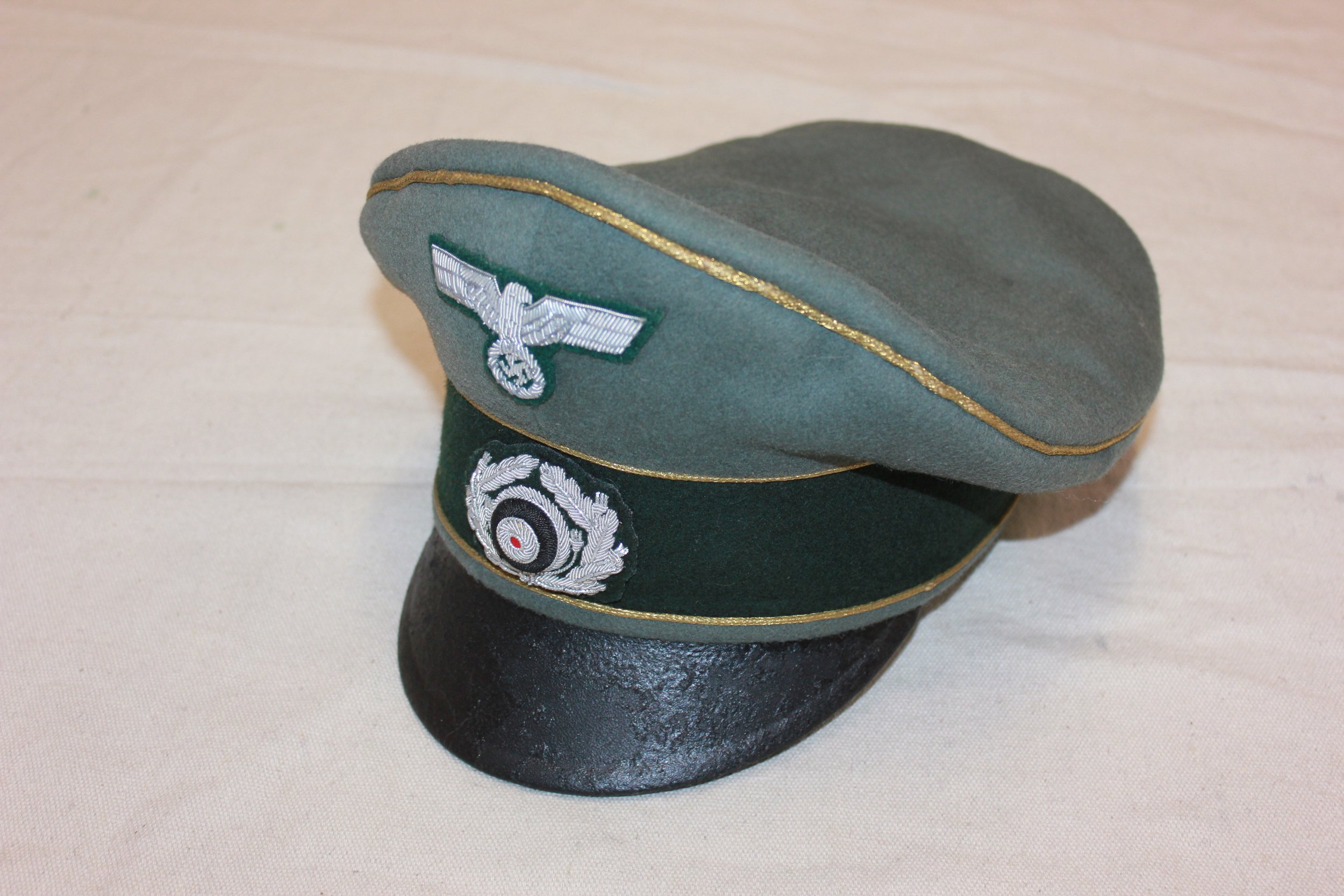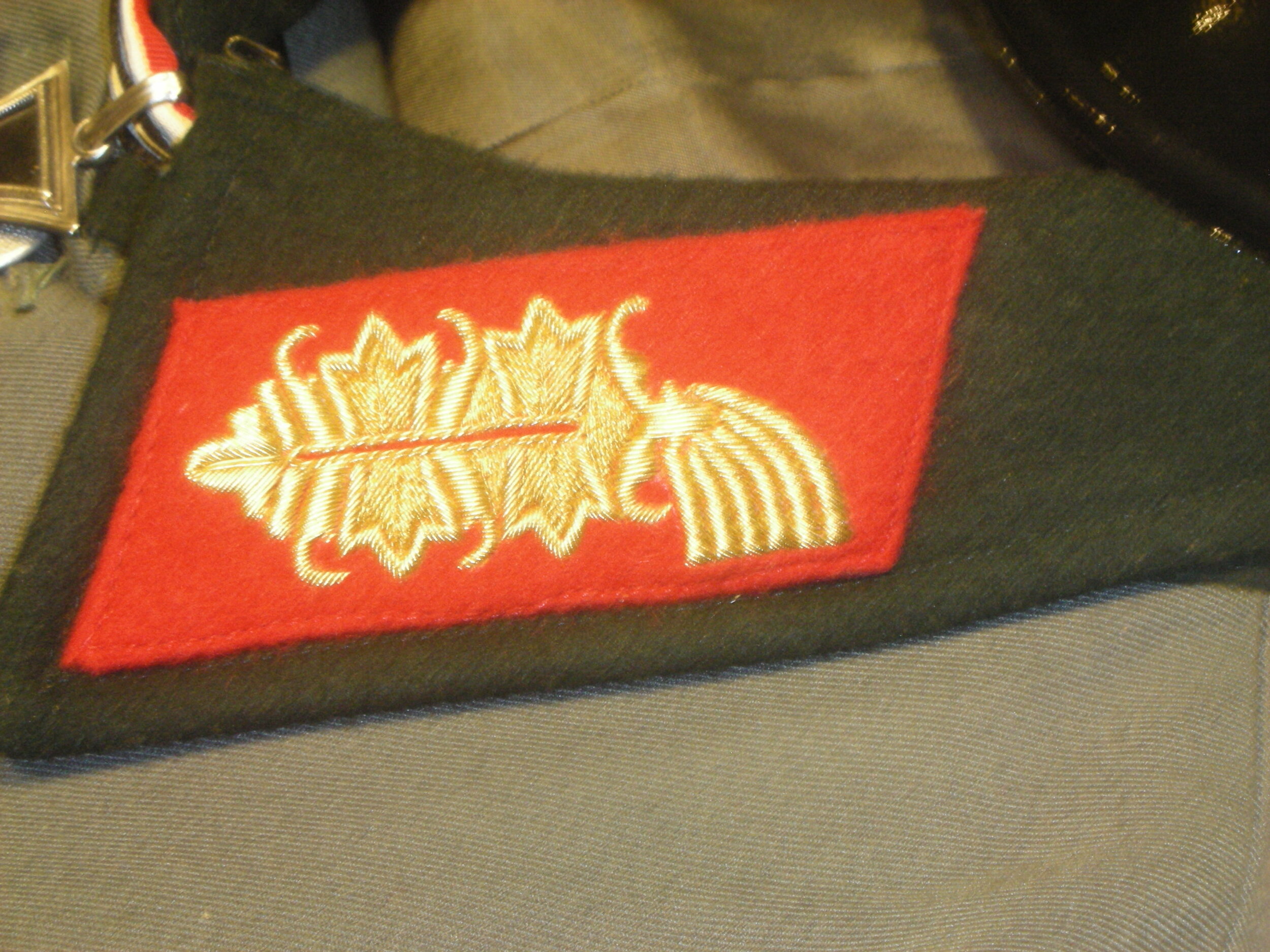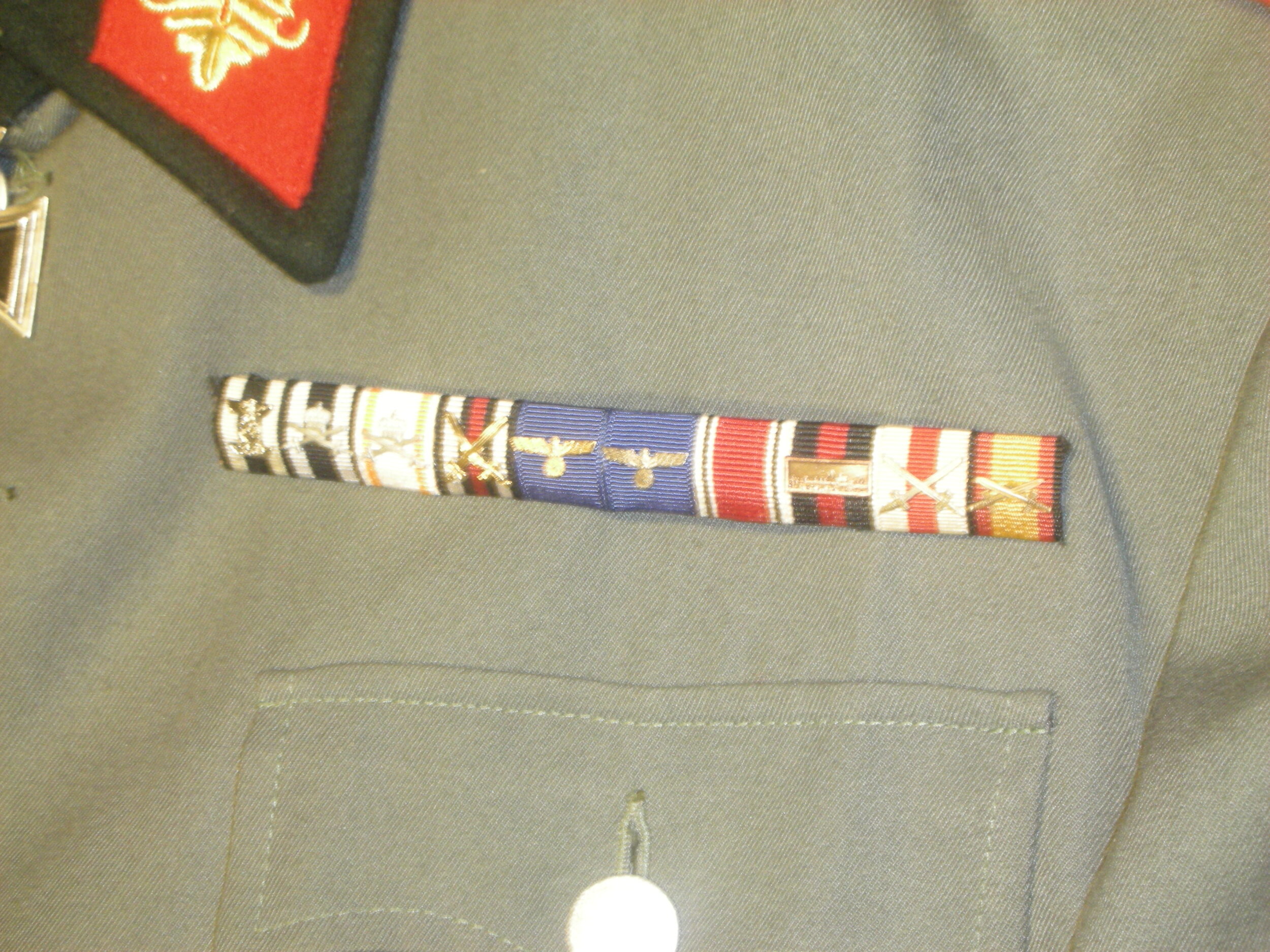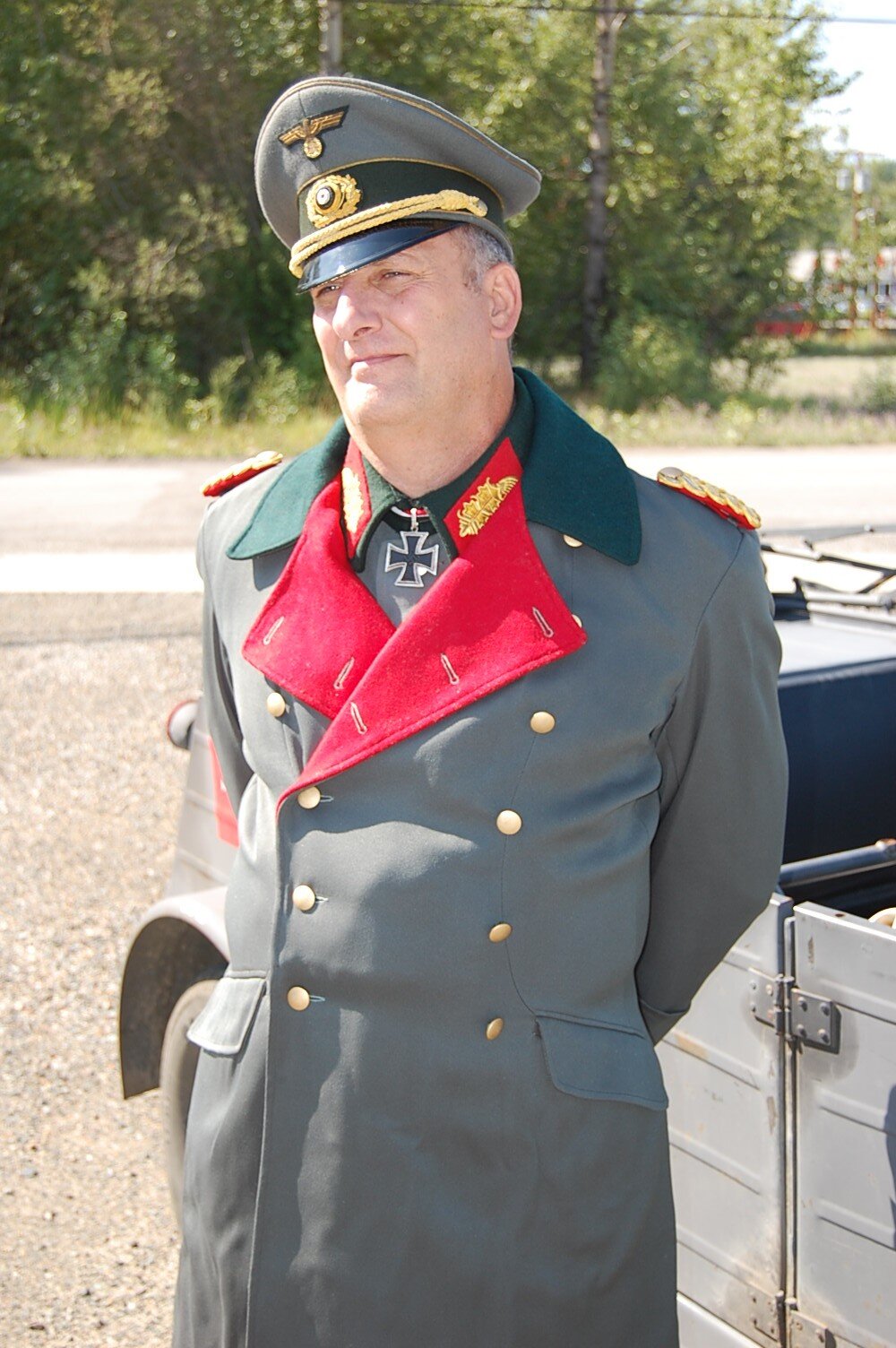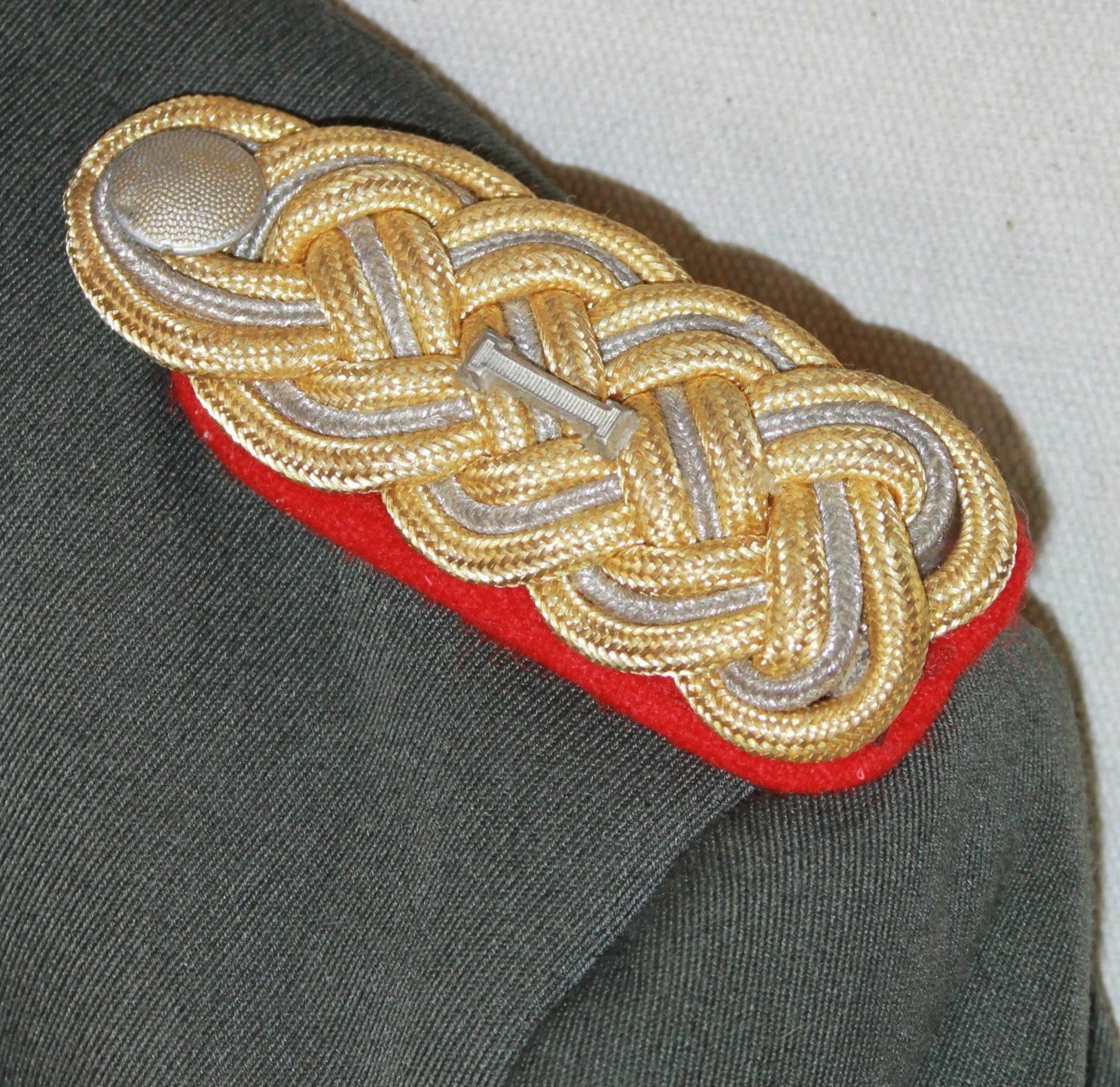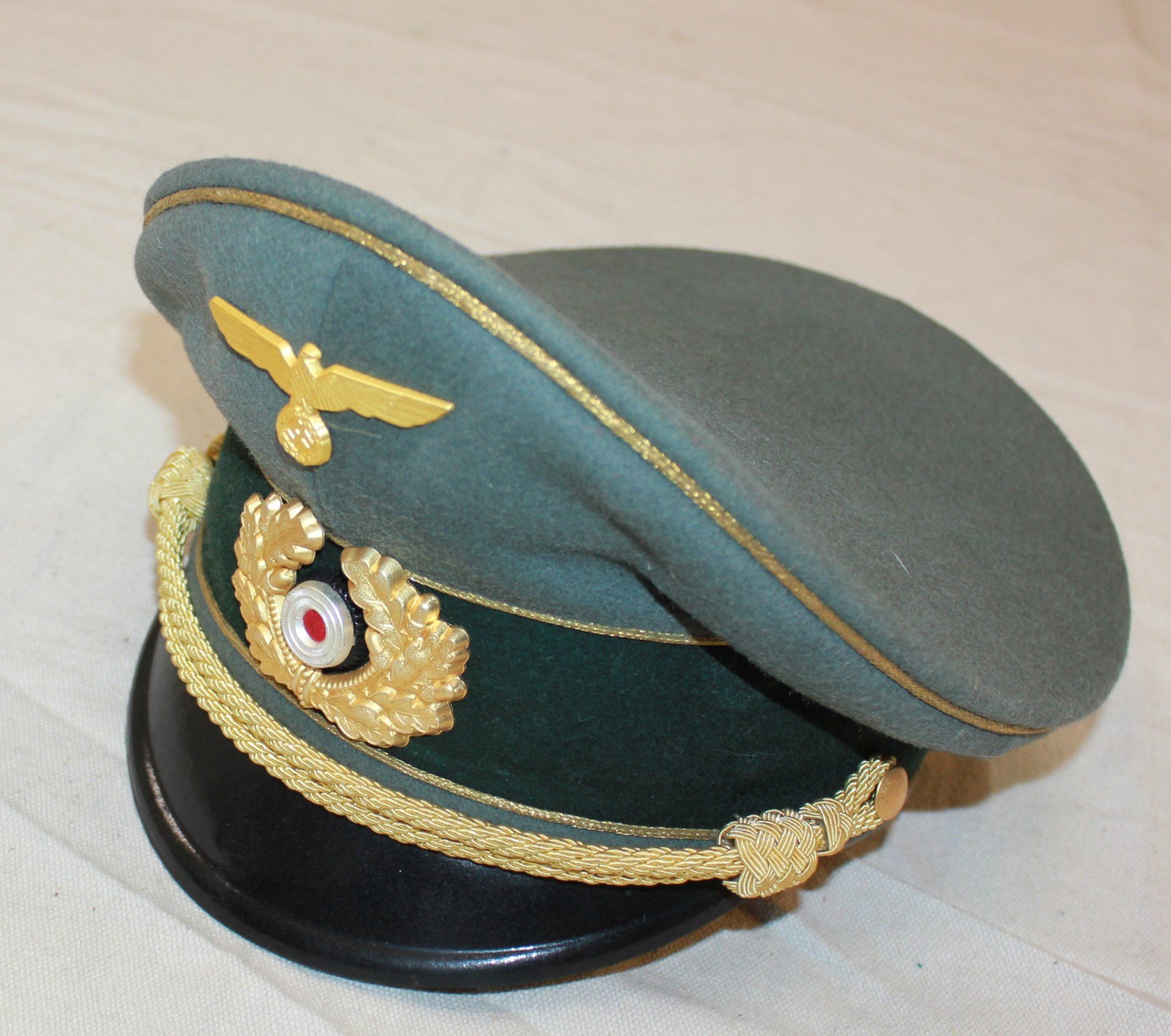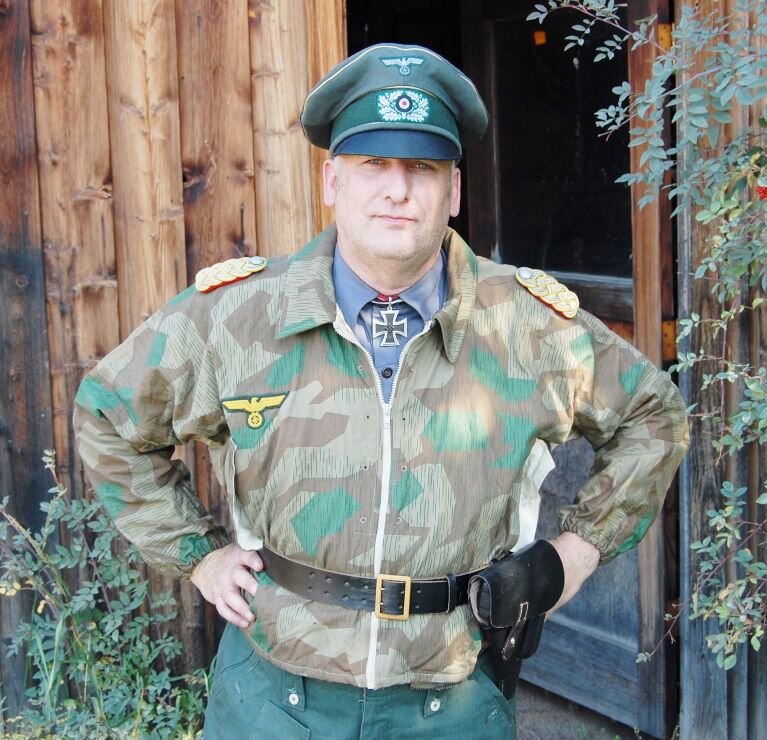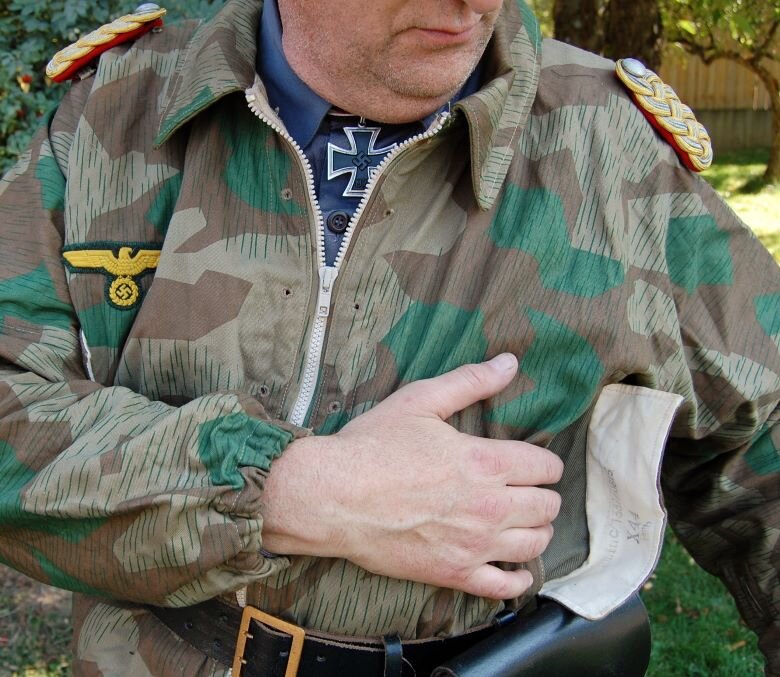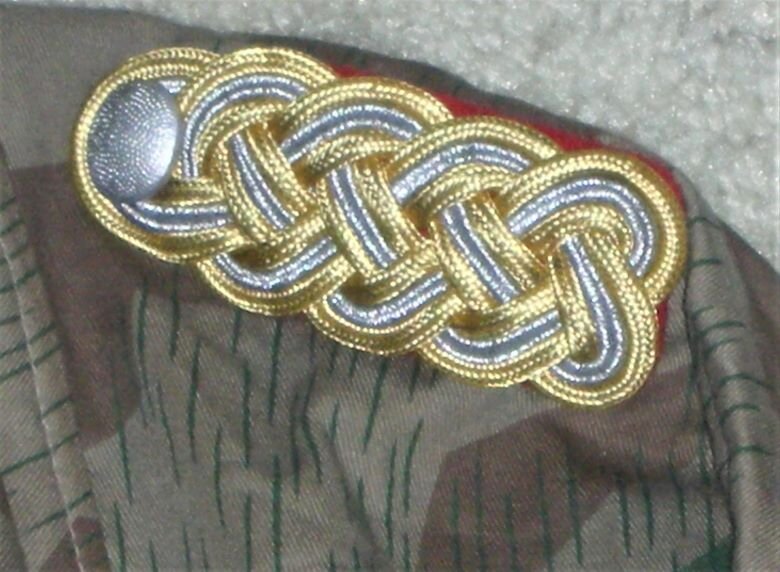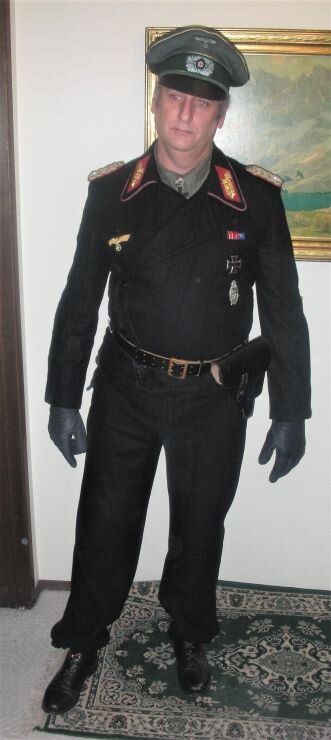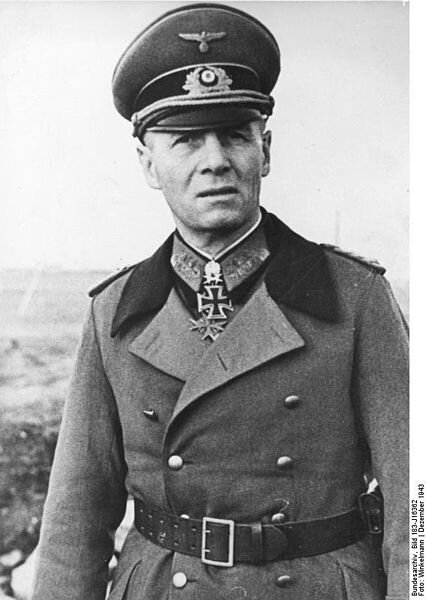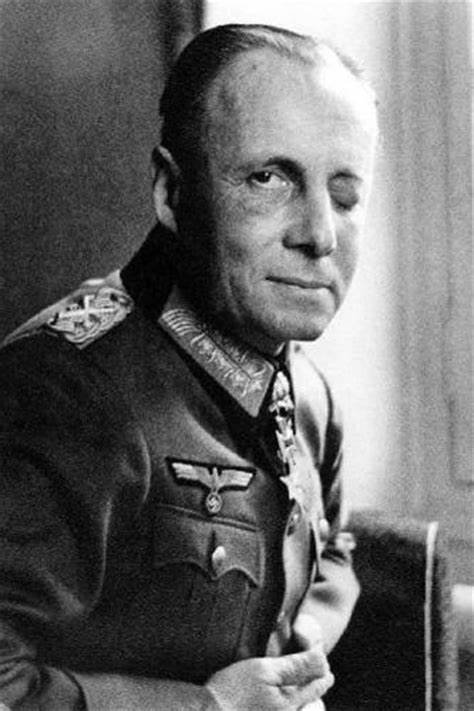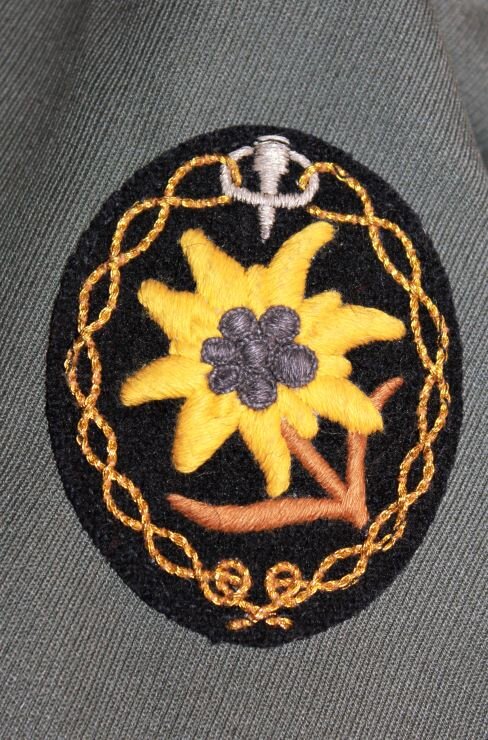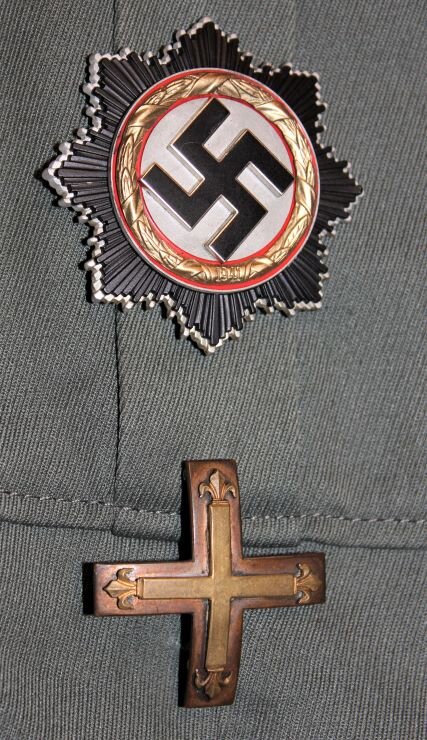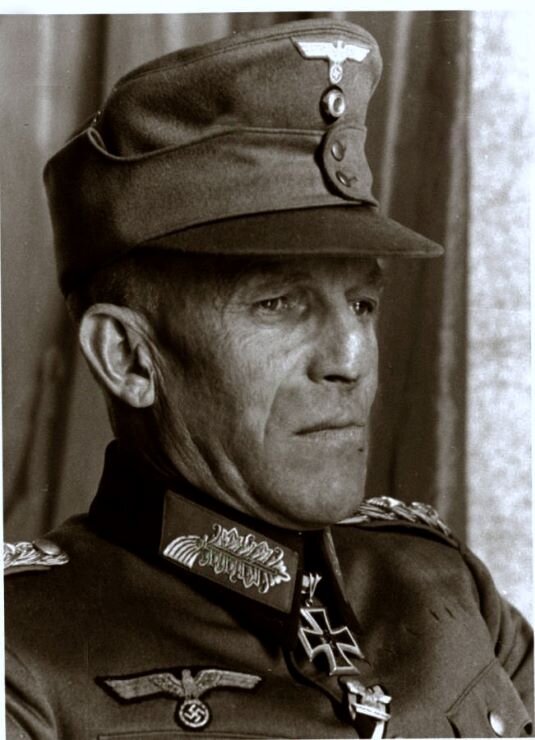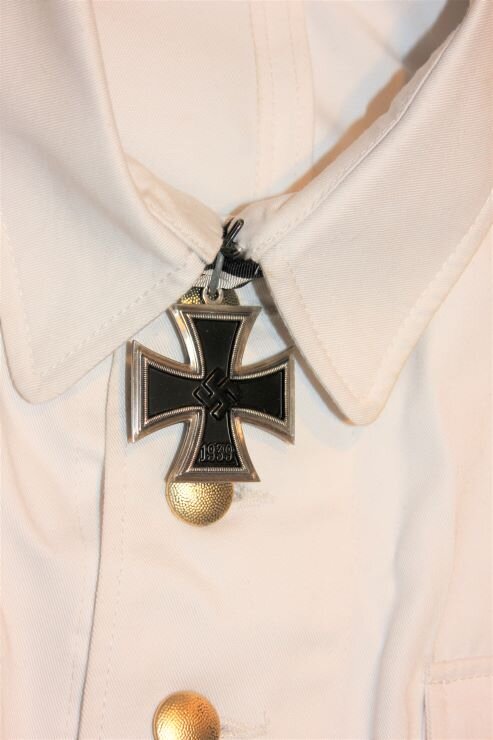Heer Generals:
“New” Heer General (unidentified at this time):
Note: Another example of looking through pockets, is always a good practice uniform, I put whatever I have of a story in them, and whatever else may be particular to the uniform, name disk, extra insignia or optional badges, and…chocolate, has been with it, I don’t dare open it though. Sometimes officers’ jacket pockets are not even functional, it’s just about looking sharp!
Heer Brigadier General, Walking Out Dress, with his Overcoat:
This newly minted general officer is a veteran of action in three conflicts: the First World War, the Spanish Civil War, and now is commanding a Panzer Division in 1942. Decorating the fine quality uniform worn for a ceremony is the gold and red collar and shoulder insignia of the rank of Brigadier General, and the national emblem is done in gold bullion. Decorated in three conflicts, this pilot won both the 1st and 2nd Iron Crosses during both the 1914-18 and the current war.
He has also received the “very rare” Spanish-Condor Legion Tank Badge and wears a rare, if even authorized, Spanish Campaign Cufftitle as well, he also has a Spanish Silver Wound Badge. He has been awarded the Panzer Assault Badge in Silver for his combat role in the present conflict and has proven his leadership in combat with not only the 1939 version of the Iron Crosses I and II Classes! But the Knights Cross of the Iron Cross at his throat is the one that says it all, as well as the German Cross in Gold on his breast pocket; these say he never backs down and makes good decisions.
On his ribbon bar, he has WWI decorations, as well as Condor-Legion, Polish Campaign, and the Anschluss of Austria, and two Long Service ribbons, for over 12 years. He also wears standard general officer breeches and an overcoat along with a finely made General Officer Schirmmutz.
One thing we get hung up on is personalized uniforms of higher ranks, rare ya, but there were many, that have little information on, nor records now, some just never received any film propaganda time, or even a lot of pictures, a large number of Majors, Colonels, and even Generals, that received little historical mention, and promotions were some spur of the moment, andor work strictly in the management and operations and not front line people. They have disappeared into time, as they say.
At some point even a soldier starts to get old, and tired, of looking at things through different eyes after a while, so they find their way into administrative or call it a desk job, it just happens, and for other various reasons, be it competitive, or political, they fall into the background, and retire if possible. To have been there for WWI and the Spanish Civil War, is a lot in himself, maybe a Leutnant through battlefield promotion, had become a Lieutenant by the Armistice, ending the First World War, and a Major after Spain, he would have been up in age by his Second World War participation, and gathering speed in promotions, as the War intensified, and the bourdon became all the more for leaders that get things done. And that’s all I got to say about that. The list I just dug up had 849 in WWI in the “Army,” I assume is Heer-Wehrmacht, which works for me, and I think more, and then of the Colonels, Majors, battlefield promotions, there were many, many un-recognized Captains, and so forth.
“new” Generalmajor Ersatzdivisionen Wehrkreis I, Ersatzheer:
Over 19,000 German military personnel volunteered in the Spanish Civil War. The majority were Luftwaffe members, but the Heer supplied a small contingent of Panzer forces as well as advisors from other branches, including those that supported the combined Panzer u. Infanterie force training. From Wehrkreis I in Northeastern Germany, the officer was assigned to Infanterie Division 1. Seriously wounded in the Polish Campaign and unfit for front-line combat, his skills were utilized by the Ersatzdivisionen or Replacement and Training Divisions headquartered in Königsberg. The Ersatzdivisionen were the lubricant that oiled the formidable German military machine.
These began formation after 27. August 193,9 with conscription, training, and personnel replacement for the appropriate Wehrkreis. The divisions’ controlled mobilization policies and the actual call-up and induction of men, including all types of military training, including the selection and schooling of officers and non-commissioned officers; the dispatch of personnel replacements to field units Schlachterfelder in Ostpreuß or Battlefields of East Prussia was printed by the command of Wehrkreis I to promote military pride in the region’s history. This card celebrates Tag der Wehrmacht or Day of the Military as an all-inclusive fun time supporting the Wehrkreis.
In this case XVII in Wein, Österreich, or Austria, in response to their requisitions, and the organization of new units. Under the control of the Ersatzheer or Replacement Army, these Ersatz u. Ausbildung Division rose in strength from a total of 996,000 men at the start of the war to a peak of 2,572,000 in Dezember 1944. The Roman Numeral I attached to the shoulder insignia of the general’s piped Model 1936 dress Bluse identifies him as part of the command structure of Wehrkreis 1. Awarded the Verwundetenabzeichen in Silber, the Eisene Kreuz I. u. II. Klasse und Infanterie Sturmabzeichen in Silber was awarded for his leadership in the action in Poland that caused his debilitating wound.
General, Customized Splinter Smock:
Major General, Panzer Division, Black Wrap Uniform:
A lead from the front type of General, he’s had General Grade insignia added to a standard panzer uniform, for us in a general command tank with its extra radio sets installed. He wanted to be up close with his men so they could see he was with them, inspiring his men. A uniform may be seen in a propaganda film or modern action movie, but they did exist, albeit few, and there were more Colonels and Generals of the Panzer units than one might think, even though they were never in the tanks.
On his collar, implying an older, early enlisted uniform, carries the rose piping (Waffenfarbe) still. He is a combat leader and has been for some time, indicated by his Knight’s Cross of the Iron Cross, and the Iron Crosses 1 and 2 Classes. He also carries the Panzer Assault Badge, possibly won in Poland or France. His ribbons Bar denotes over 12 years of service, as well as the “Ost”, was only awarded to those who served through that first Winter in Russia, it had been the worst recorded to that date, and is known widely (Rightfully So) as the “Order of the Frozen Meat”.
This is another one of my favorite uniforms. The Black-Special-Wap in use for Commanding Officers, albeit quite rare, did exist; the uniform was popular, and the Panzer Korps propaganda was huge, they were admired even by guys who were not Panzertruppen. Ana, if anyone can get things-its’s an officer. The uniform set has the popular Generals Crusher Schirmmutz, but a crusher was used during one photoshoot, with standard panzer trousers, belt, holster, and combat boots would be worn. I think I first saw a Panzer-Wrap in the movie “The Battle of the Bulge” way back when, and I was impressed!
Field Marshal Erwin Rommel, Tropical Uniform:
Erwin Johannes Rommel (15 November 1891-14 October 1944), popularly known as the “Desert Fox” (Wustenfuch), was a German Field Marshal of World War II He won the respect of both his own troops and the enemies he fought.
He was highly decorated in the 1st World War (The Great War), earning the (f) Pour le Mérite for his exploits on the Italian Front. In the Second World War, he further distinguished himself as the commander of the 7th Panzer Division during 1940, in the Invasion of France.
However, it was his leadership of the German and Italian Forces in the North-African Campaign that established the legend of the “Desert Fox.” He is often considered to have been one of the most skilled commanders of desert warfare in the conflict. He would be pulled out of Africa when he was quite sick, prior to its loss. He was then used to helping build up the likely beachheads the Allies were quite likely to use for an invasion, again in France.
This uniform displays the Continental style insignia, which was actually common, popular even, and it displays most of the decorations he commonly wore, the signature being the famous (f) Pour le Merite (The Blue Max as it was referred to by Americans), from his actions in the First World War, it was worn at the throat, with his Knights Cross of the Iron Cross, Worn in WWII, his other favorite is the Panzer Assault Badge. Interestingly, he wore a general’s rank collar insignia, with Field Marshal Shoulder Boards, with the silver baton devices on them.
While he did have a Tropical uniform and wore it often in the desert, It seems he had one, later too, for special foto-shoots and other events too, in Europ, the original faded beyond comprehension, wand worn I think was moved to the closet, locally, as it still exists in another collection. He is seen in photographs, in both Schirmmutz (with the English Goggles) on it, or the Troppenhelm (Pith Helmet) along with a wide, patterned down officers’ belt. The Schirmmutz is a standard pre-1944 with Gold piping and chin chord, with Silver Eagle and Wreath. Rommel wears a tropical-weight shirt beneath this uniform, closed at the neck where he displays his awards. Breeches are cut from the same material with a bright red strip down each leg. Tall Boots completed the uniform. His General Staff and Field Marshal’s Baton as well.
General der Panzer Truppe, ‘Graf Gerhard von Schwerin’:
Gerhard von Schwerin had been born to wealthy Aristocratic Prussian Parents in 1899. His father had been a Civil-Official for the Prussian State Government. When he was just 15, he entered military cadet school in Koslin. He then passed and entered the Prussian Army’s 2nd Foot Guards Regiment as a commissioned officer cadet or Fahnrich, then moved over to the 2nd (1st Pomeranian) Grenadier Regiment. He went on with his career and saw action with the infantry on both the Eastern and Western Fronts of the First World War.
He continued with his service in the military following the end of hostility, and joined the Military Academy in Schwerin, and was there when German Chancellor, Adolf Hitler seized all autocratic governing power of the country, the party started a paramilitary political revolution in Berlin, and they abolished the Weimar republic, taking over, and putting into law the Enabling Act of 1933, and declared he was in charge of the new 3rd Reich. Europe would never be the same.
In October 1938, Schwerin was promoted to the rank of major and by the end of the 1930s, had become a Staff-Officer with Oberkommando der Heers (Supreme High Command of the German Army).
In January 1939, whilst working at the British/U.S.A. intelligence section of the German War Ministry at the “German Embassy in London” Schwerin made a clandestine, and dangerous personal approach to the British Officials, suggesting that if it abandoned its policy of appeasement towards the Third Reich, and that they should-consider launching a coup de tat, against the National Socialist Government controlled by Adolf Hitler warning of his danger to the world. He also mentioned that Neville Chamberlain should be replaced as Prime Minister by Winston Churchill. However, but, the British Government swept it all aside, not wanting to make waves, and stick with their political plan, (which bit them in the butt later), even though he took a huge risk, he would have been caught, he would have been considered to have, constituted high treason under the Third Reich's jurisdiction and hung if discovered, they dismissed the subject as an internal matter for the German high command. Then, in April of 1939, Schwerin was promoted to the rank of lieutenant colonel.
By 1944 he was General der Panzertruppe, and tasked with defending the city of Aachen, with the men under his command, the 116th “Windhound” (Greyhound Panzer Division) but it had been reduced to 600 men, 12 tanks, with no artillery pieces, he had in an attempt to prevent civilian casualties and to protect the city's huge historical architecture, he left a letter at the telegraph office to be given to the American commander informing the American General Courtney Hodges that he intended to surrender the city without contest. But the Americans had stopped to regroup, the letter had fallen into party functionaries, and Adolf Hitler soon ordered von Schwerin to be arrested and put on trial for treason. Field Marshal Rundstedt and Walter Model both came to his aid and saved his life, receiving only a severe reprimand.
He was sent to the Italian front, even receiving a promotion, to General der Panzertruppe commanding General of the LXXVI Panzerkorps. But the end of the war came to him, and he was captured by British Forces on April 26, 1945. He was released at the end of 1947. He was active after the War, he tried to rebuild the German Army, but had problems, and it was a big stink, then started working as an advisor on military policy, for the parliamentary group of the liberal Free Democratic Party of Germany, He passes-away, 29 October 1980, at the age of 81. He claimed he had saved Aachen from disaster, but the town had been nearly leveled by the Allied Forces’ Air Raids and fighting throughout the city. This is the first image I think of when I think of a German General from WWII.
Ritterkreuzträger, Gerneralmajor, Hans Karl Christian Degen, 2. Gebirgsjäger Division, Uniform Set:
Generalmajor Hans Karl Christian Degen was the Commander of the 2. Gebirgsjäger Division from November 1943 until February 1945. During this time, the division was transferred from Norway to the Western Front via Denmark, where the division was engaged in the fighting around the city of Trier against the US. Forces.
He was a 1914-1918 veteran. Degan also served in Spain, earning the Deutsche Spanienkreuz mit Schwertner in Bronze, returning to Innsbruck, Austria, to form the division from the former 6. The Austrian Mountain Division following the Anschluss in April of 1938.
This is the first uniform in the set, it presents his dress uniform as seen after the award of his Ritterkreuz in early 1945 while serving on the Western Front. Sewn above the Ost Front Campaign Ribbon, the Ehrenblatt-Spange des Heers was awarded in 1945. The first uniform of the set has a custom embroidered Gebirgs-Edelweiss in gold on the sleeve of the uniform. As a veteran of WWI, Degan wears the Eisernes Kreuz II with the 1939 Spange on his ribbons bar along with the 1st Class award on his pocket. Additionally, he wears the 1914 Verwundeten Abzeichen in Schwartz and the Honor Cross ribbon. Degen earned the Deutsche Kreuz in Gold in March of 1942.
With this uniform, Generalmajor Degen wears Stiefelhosen with bright red stripes on the sides, indicating “General” rank, and has a General-Officer’s Schirmmutz. As with most Generals, he wore a brown leather belt with a gold double-claw buckle on it.
Uniform #2 of the set of Generalmajor Hans Karl Christian Degen, it’s his white Summer uniform as seen after March of 1942. This was the date he received the German Cross in Gold. Up to this point, Degen and the division had been mobilized on August 26, 1929, and entered action in September 1939, as part of Army Group South, in Southern Poland and they took part in the march to capture the city of Lemberg.
After the Campaign in Poland, the division took part in the invasion and occupation of Norway in May 1940. The division took part in actions in central Norway, then in operations against the British Forces while attempting to link up with 3. The Gebirgsjäger Division was holding the Northern port of Narvik. It then spent some time on occupation duties in the far North of Norway and into Lapland. With the opening of Operation Barbarossa (The Invasion of the Soviet Union) in June of 1941, the division became part of XIX Gebirgskorps in 20. Gebirsarmee, and they took part in the drive towards Murmansk and would fight alongside the Finns.
His summer white Dienstbluse Degen sports his newly awarded German Cross in Gold. The uniform was worn with the standard general officers’ Schirmmutz and Stiefelhosen with red general stripes, the white Bluse was normally worn for dress occasions and could be completely stripped of insignia for washing. Collar insignia, by regulation, was not worn with this uniform. Sword of Dress Dagger was suspended employing an internal cloth strip (or strap), with no belt normally worn with the jacket.






